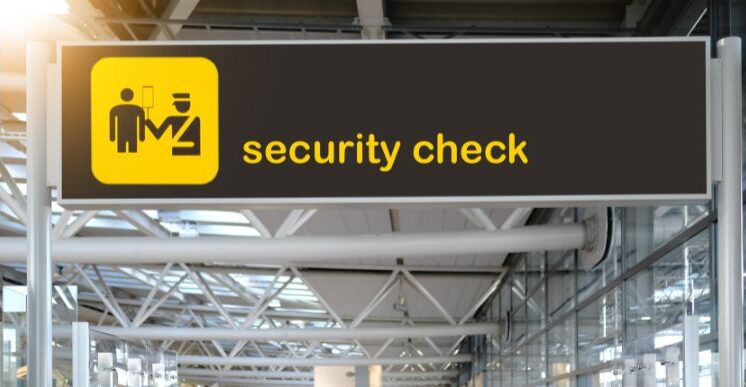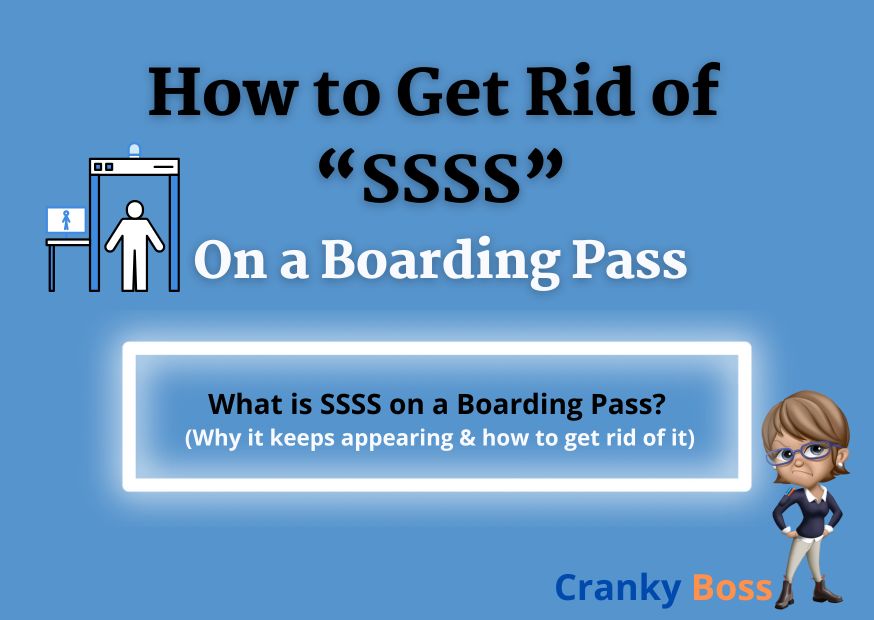The letters SSSS indicate that you have been selected for additional security screening by the Transportation Security Administration (TSA) before boarding your flight.
So if you’ve ever seen SSSS on your boarding pass, you may have wondered what it means and how to avoid it in the future. I will explain what SSSS stands for, why it appears on boarding pass, and what can be done to reduce the likelihood of it happening again.

There are a number of mysterious abbreviations you may typically see on your boarding pass. For instance SBY on a boarding pass stands for Standby, and GTE on a boarding pass which means Gate Entry. But what you really don’t want to see is the dreaded SSSS, indicating you’ve been selected for additional security screening. The SSSS also shouldn’t be confused with SEQ on a boarding pass which is an abbreviation for sequence. In fact the four S’s will typically be in big black bold letters.
What Does SSSS Mean on a Boarding Pass?
The SSSS on your boarding pass stands for Secondary Security Screening Selection. This means that TSA or another airport security agency has flagged you for extra screening. When a passenger is flagged for SSSS screening, their boarding pass or boarding card will show SSSS in bold letters.
Passengers with SSSS on their boarding pass are subject to more extensive screening procedures, such as thorough pat-downs, bag searches, and additional questioning. While this process is designed to ensure flight safety, it can be time-consuming and stressful for travellers.

Where is the SSSS printed on the boarding pass?
The SSSS designation is typically printed in the following locations on a boarding pass:
- Near the Barcode: On most boarding passes, SSSS is usually printed near the barcode, which is scanned at security checkpoints. This placement ensures that security personnel can easily see it during screening.
- In the Passenger Information Section: It may also appear in the passenger information section, along with your name, flight number, and other details.
- At the Top or Bottom: Depending on the airline and format of the boarding pass, SSSS may be printed at the top or bottom of the boarding pass. Sometimes even both!
- In Bold or Highlighted Text: To make it more visible, some boarding passes may print SSSS in bold or highlighted text, drawing attention to it for security staff.
If you see SSSS on your boarding pass, it serves as a clear indicator that you will need to undergo additional security screening at the airport.
What Triggers SSSS on a Boarding Pass?
It’s important to note that the exact criteria for selecting passengers for secondary screening are not publicly disclosed. This is to maintain the integrity of security measures.
There are however several factors that might trigger the SSSS on a boarding pass. These triggers are usually related to heightened security concerns, suspicious travel patterns, or certain behaviours flagged by airport security systems.
Here are several possible reasons why you might receive a boarding pass with SSSS.
- Traveling to high-risk countries
- Booking last-minute international flights
- Using one-way tickets
- last-minute flight bookings or purchasing tickets with cash may increase the likelihood of being selected for SSSS screening.
- traveling to or from certain countries that are known for heightened security measures
- People with travel histories that raise concerns or who have been on government watch-lists could also trigger SSSS selection.
- Inconsistent travel patterns
- Having a name that closely resembles someone on a watch list. This is because security systems use algorithms to compare passenger names against various watch lists. These lists include those maintained by the TSA and other agencies. If your name is similar to someone on the list, it may raise a flag for additional scrutiny. This often results in SSSS being printed on your boarding pass.
Is SSSS on Boarding Pass Permanent?
Many passengers wonder if having SSSS on their boarding pass is permanent. The answer is no. SSSS is not typically a permanent status but rather a random or situation-based selection. However, some passengers may receive SSSS more often than others due to travel patterns or previous security checks.
What Is SSSS Shooter?
The term “SSSS shooter” is sometimes used by travellers to describe those individuals who are selected for extra screening regularly. This term is more of a slang term and is not an official classification by any security agency. It simply refers to the fact that certain passengers seem to be flagged for SSSS more frequently than others. This is possibly due to their travel patterns or security concerns.
How to Get Rid of SSSS on Boarding Pass
Getting rid of SSSS on your boarding pass may seem challenging, but there are a few steps you can take to reduce the chances of receiving this security flag again.
1. Update Travel Details
Make sure your travel details are consistent and up-to-date, including your passport, identification, and flight information.
2. Cash Tickets & Last Minute Travel
Avoid making last-minute flight bookings or paying for tickets in cash, as these can trigger extra security screening.
3. Apply to Traveller Programs
Apply for programs like TSA PreCheck or Global Entry can help minimize the chance of being selected for SSSS screening. These trusted traveler programs allow you to go through expedited security checks at the airport. This makes it less likely that you will be flagged for extra screening.

If you receive SSSS on your boarding pass once, there’s no need to be overly concerned. It can happen randomly to travellers from time to time, and that’s quite common.
However, if you notice that you’re getting SSSS repeatedly on several trips, it could be an indication that you’re on a certain list for additional screening.
Even if this happens, don’t panic. It can be addressed.
4. Apply for a Redress Number
The best way to resolve it is by applying for a Redress Number through the DHS TRIP program (Traveler Redress Inquiry Program). By submitting a request, you’ll provide basic information about your situation, which will then be reviewed and investigated. If there’s a misunderstanding or a reason you’re being flagged, it can hopefully be corrected through this process.
This process generally takes about one month.
Can anyone apply for a redress or only US citizens?
Anyone can apply for a Redress Number through the DHS TRIP (Traveler Redress Inquiry Program), not just U.S. citizens. The program is designed for both U.S. and non-U.S. citizens who believe they have been subjected to additional security screening or have experienced travel-related issues due to being mistakenly identified as a security threat.
Eligibility for DHS TRIP
- U.S. Citizens: Can apply if they feel they have been wrongly flagged during travel.
- Non-U.S. Citizens: Can also apply, particularly if they travel frequently to or from the U.S. and experience similar issues.
When applying, travelers will need to provide personal information and details about their travel experiences, which will be reviewed by the Department of Homeland Security. This helps ensure that any inaccuracies in security screening are addressed, improving the travel experience for everyone.
What Is SSSS on Boarding Pass International Flight?
Receiving SSSS on an international flight can be more common due to stricter security protocols for international travel. When flying internationally, passengers are often subject to additional screening regardless of their boarding pass status. However, those with SSSS will face even more scrutiny. This extra screening can include swabbing for explosives, detailed questioning, and a more thorough search of both your luggage and person.
In Which countries do you see SSSS?
The SSSS process is controlled by the TSA (Transportation Security Administration), which applies it mainly to U.S.-bound flights or flights departing from the U.S.
While SSSS is primarily a U.S.-based security measure, international airports worldwide are required to implement this additional screening on selected passengers flying to the United States. The likelihood of receiving SSSS can vary based on travel patterns, routes, and sometimes random selection.
The SSSS (Secondary Security Screening Selection) can appear on boarding passes in any country, as it is part of the TSA’s security measures for flights to and from the United States. However, it is more commonly seen in certain situations or specific countries where enhanced security protocols are required. These countries might include those flagged by the U.S. for higher security risks or those involved in heightened geopolitical tensions.
SSSS Airport Security Process
If you see SSSS on your boarding card, be prepared for extra security at the airport. Upon arrival at the security checkpoint, you will be separated from other passengers and taken for further screening. This process can vary from airport to airport but usually involves being questioned by TSA agents, going through additional scanning, and possibly having your luggage opened and inspected.
Once the SSSS screening is complete, TSA agents will stamp your boarding pass to confirm that you’ve been cleared to fly. While this process is time-consuming, it is a necessary part of the enhanced security protocols to ensure safety during air travel.
Is SSSS Random?
In many cases, the SSSS selection is random. However, specific factors can make it more likely for certain passengers to be selected. As mentioned earlier, last-minute bookings, one-way flights, or travel to specific destinations may increase your chances of getting SSSS on your boarding pass. Additionally, passengers who have experienced security incidents in the past may find themselves flagged more frequently.
Can TSA SSSS Be Avoided?
The selection process can sometimes be random, and certain travel behaviours as mentioned above may always increase the chances of being flagged for additional screening.
However, participating in trusted traveller programs like TSA Precheck or Global Entry may reduce the likelihood of receiving SSSS on your boarding pass in the future. These programs once approved, offer a smoother and faster security process at the airport. Furthermore, if you are getting the dreaded SSSS more than not, then it’s probably time to apply for a Redress Number through the DHS TRIP.
Final Thoughts on How to Get Rid of SSSS on Boarding Pass
By understanding what triggers this additional screening and taking steps to avoid those triggers, you can reduce your chances of receiving the SSSS on your boarding pass again.
Programs like TSA Precheck and Global Entry are excellent ways to streamline the security process and lower your odds of being selected for extra screening.
Make sure to always check your boarding pass in advance so that you know what to expect at the airport. If you do receive SSSS, arrive at the airport early to allow plenty of time for the additional security procedures. This is particularly important for passengers who may already suffer from travel anxiety or families who are travelling with kids.
Encountering SSSS on your boarding pass can feel unsettling, but it is important to remember that it often happens randomly and is not usually a cause for alarm. If you only see it occasionally, there’s typically no reason to worry. However, if you consistently receive SSSS on multiple trips, it may suggest you’re on a list for additional security screening. In such cases, applying for a Redress Number through the DHS TRIP program is a proactive step. This program allows you to address any potential issues by sharing your travel concerns, which will be investigated.
Most importantly, remember that receiving SSSS does not define your travel experience, and with the right steps, it can be resolved, allowing you to focus on enjoying your journey.
And whilst we are on the topic of boarding passes, ensure you don’t ever share your boarding pass online or through your social media platforms as there is great risk in doing so.
Finally, if you are travelling don’t forget to check out my ultimate travel packing list which includes items you wouldn’t think of!
Safe travels!

